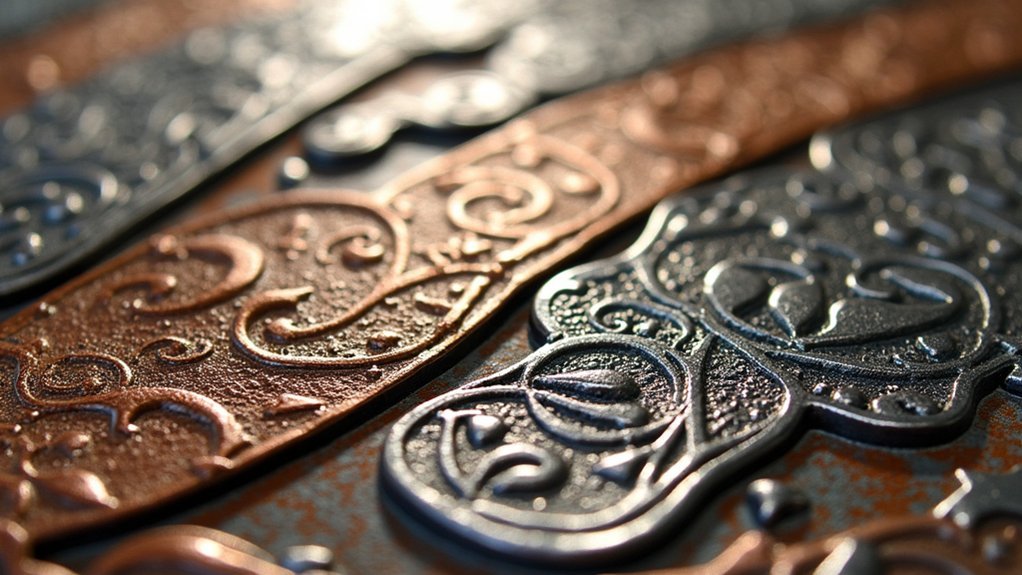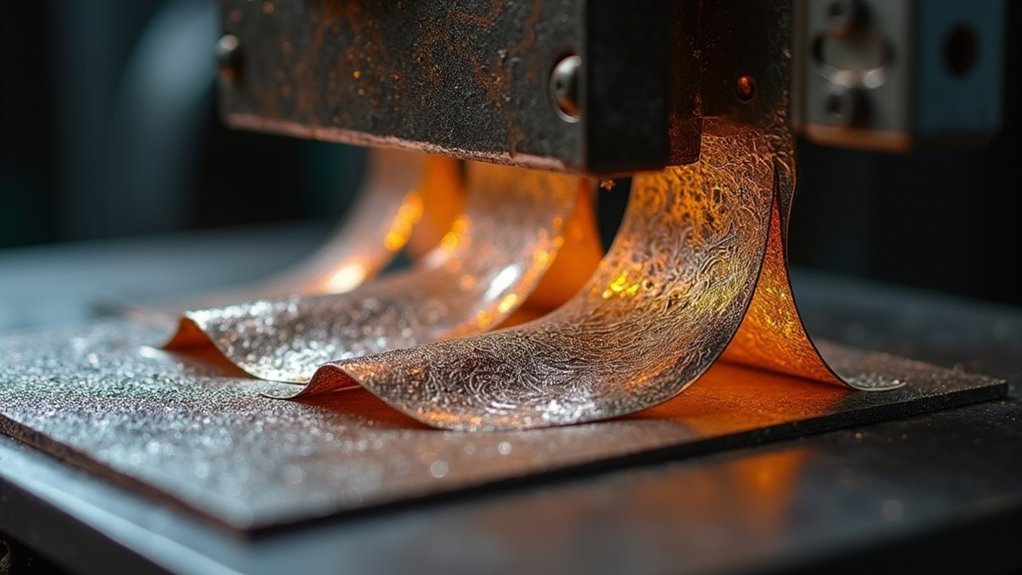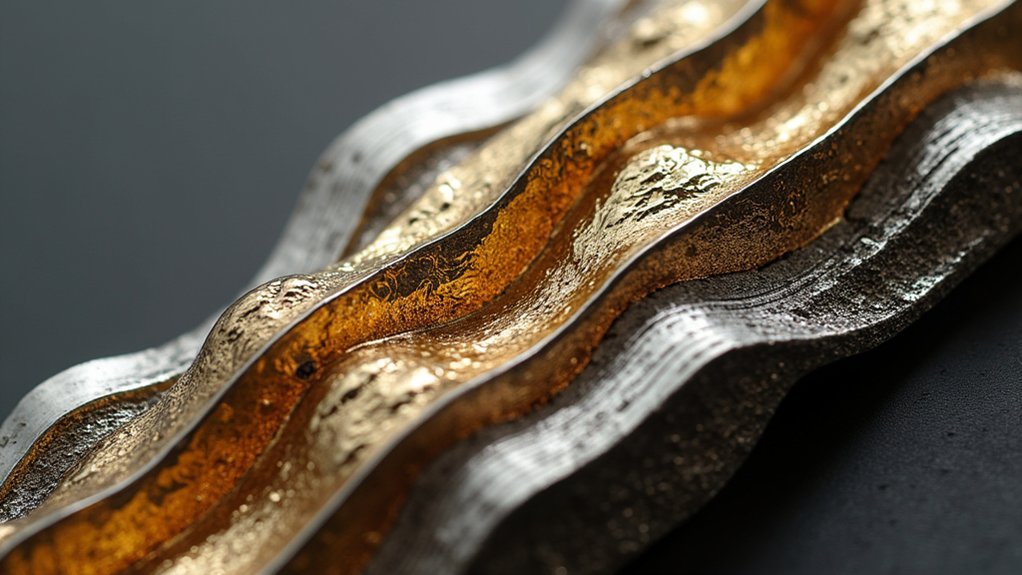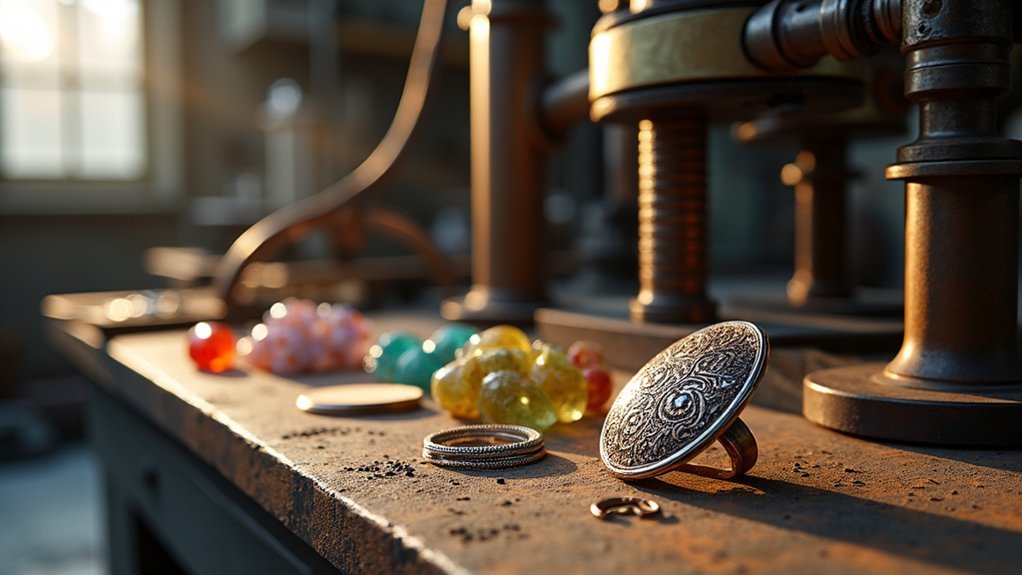Hydraulic presses empower you to create professional jewelry with textured metal designs, three-dimensional hollow forms, and precise fold-formed shapes. You’ll craft custom bracelets with perfect curves, produce intricate components using silhouette dies, and develop mixed metal laminations with seamless fusion. The consistent pressure (2000-3500 psi) guarantees reliable production of identical pieces for your jewelry line. Discover how these powerful tools can transform your artistic vision while boosting your efficiency and profitability.
Stunning Textured Metal Designs With Pattern Plates

While traditional metal texturing techniques require hours of painstaking handwork, hydraulic presses have revolutionized how jewelry artists create intricate surface designs.
You’ll achieve professional-looking patterns with remarkable consistency using this powerful tool. By placing your metal sheet between a pattern plate and urethane pusher, you’re able to transfer detailed designs—from florals to geometrics—with precise hydraulic pressure.
The beauty is that your metal’s thickness remains virtually unchanged while gaining stunning texture. Steel or brass pattern plates offer endless creative possibilities in your jewelry making journey.
Transform metal while preserving its dimensions—pattern plates unlock limitless creative potential for your jewelry designs.
You can experiment with different pressures and materials to develop unique finishes that would be nearly impossible to replicate by hand. This efficient approach not only saves you valuable time but elevates your craftsmanship with uniform, detailed results.
Three-Dimensional Hollow Forms and Domed Elements
You’ll transform your jewelry designs from flat to fabulous by creating three-dimensional hollow forms with male-female dies in your hydraulic press.
Working at pressure levels between 2000-3500 psi guarantees precise shaping while maintaining the metal’s integrity during the forming process.
For added dimensional interest, combine urethane pushers with your tooling to achieve varying depths and textures that enhance the overall appeal of your three-dimensional masterpieces.
Creating Dimensional Masterpieces
When jewelry artists seek to elevate their work beyond flat forms, hydraulic presses become invaluable tools for creating stunning three-dimensional pieces. Using male-female conforming dies, you’ll transform flat metal sheets into intricate hollow forms with remarkable precision and consistency.
Your 20-ton hydraulic press applies up to 3500 pounds of pressure, perfect for forming thicker metals like 18-gauge brass into dimensional designs such as puffy hearts. The metal puffing process with silhouette dies converts flat sheets into domed elements in minutes, adding depth to your jewelry.
For best results, incorporate urethane pushers to distribute pressure evenly across your metal.
You can experiment with various die materials—epoxy-steel or masonite—to create durable tools that facilitate unique hollow forms in your designs, ensuring each piece maintains its integrity and detailed features.
Tooling For Hollow Forms
Creating a dimensional masterpiece begins with the right tooling setup. Your journey into three-dimensional hollow forms requires male-female conforming dies that work with your hydraulic press to transform flat metal into complex shapes under pressure.
When preparing for metal forming, craft your dies from durable materials like metal or epoxy-steel that capture fine details. Always cut your sheet metal larger than the female die cavity, allowing excess material that you’ll trim later for clean edges.
You’ll discover incredible creative possibilities by stacking urethane materials with your metal before pressing. This technique produces varying depths and domed elements that add both beauty and structural integrity to your pieces.
Die Forming For Jewelers dramatically increases efficiency—you’ll create multiple identical hollow forms in a single workday, perfect for collections with consistent design elements.
Precision Fold-Forming Techniques for Unique Shapes

You’ll find that mastering both anticlastic and synclastic folding techniques greatly expands your jewelry design vocabulary, with each creating distinctly opposite curvatures when formed under hydraulic pressure.
Multi-stage folding methods allow you to build complexity by introducing sequential folds and anneals, transforming simple metal sheets into sophisticated three-dimensional forms.
Anticlastic Vs Synclastic Folds
The distinction between anticlastic and synclastic folds represents one of the most fundamental concepts in precision fold-forming for jewelry artists.
When you’re working with a hydraulic press, understanding these differences becomes essential for achieving your desired metal jewelry designs.
Anticlastic folds create elegant, flowing shapes where curves rise and fall in opposite directions. You’ll gain precise control over these sophisticated forms through consistent pressure application.
Conversely, synclastic folds produce bowl-like or dome shapes where curves rise and fall together, creating different visual effects.
Both techniques benefit from the hydraulic press’s uniform pressure, allowing you to work with thicker copper or brass while maintaining intricate details.
You’ll appreciate how these methods notably reduce manual labor compared to traditional hand-forming, freeing you to focus on creativity rather than technique.
Multi-Stage Folding Methods
While anticlastic and synclastic folds establish fundamental techniques, multi-stage folding methods elevate your jewelry creations to extraordinary levels of complexity.
By running metal through hydraulic presses multiple times with strategic manipulation between passes, you’ll achieve intricate geometries impossible with hand-forming alone.
Urethane dies become invaluable allies in this process, ensuring consistent folds and curves with remarkable accuracy.
You’ll appreciate how these dies allow for repeatability while maintaining your artistic vision.
By controlling pressure across different stages, you can experiment with various metal gauges and materials—from brass to copper and specialized alloys.
As jewelry artists master this technique, you’ll discover how each controlled press creates distinctive shapes that set your work apart in the market.
The precision of multi-stage folding delivers both artistic freedom and technical excellence in your finished pieces.
Textured Fold Variations
Creating distinctive textured fold variations requires mastery of both pressure control and material preparation when using hydraulic presses. You’ll achieve consistent results across multiple pieces by applying uniform pressure to your metal sheets, making this technique ideal for small production runs.
Try layering different metal gauges before pressing to create intricate, three-dimensional forms with compelling visual depth. Urethane dies greatly enhance your fold-forming process, allowing you to imprint specific patterns onto your metal surfaces while simultaneously creating folds.
The beauty of hydraulic press fold-forming lies in its versatility – you can experiment with various metal thicknesses to achieve different fold depths and textures. This controlled approach guarantees your jewelry pieces maintain structural integrity while showcasing unique textural elements that distinguish your work from traditional hand-formed designs.
Custom Metal Bracelets and Cuffs With Even Curves

Five key advantages make hydraulic presses essential tools for jewelry artists crafting metal bracelets and cuffs.
First, you’ll achieve perfectly even curves without distortions, ensuring uniformity in your custom metal bracelets.
Second, by applying up to 3500 pounds of pressure, you can effectively shape thick metals like brass and stainless steel with minimal effort.
Urethane dies enable you to create intricate textures and designs that enhance your bracelet’s visual appeal.
Additionally, silhouette dies allow for quick production of matching bracelet sets in various sizes, expanding your product range.
Perhaps most importantly, the hydraulic press greatly reduces production time, freeing you to focus on design rather than repetitive manual forming.
You’ll create professional-quality pieces while saving valuable creative energy.
Intricate Metal Components Using Silhouette Dies
Beyond crafting perfectly curved bracelets, your hydraulic press offers remarkable versatility through silhouette dies.
These specialized tools transform flat metal sheets into stunning three-dimensional shapes without cutting the metal.
You’ll create intricate metal components like puffed hearts, pendants, and earrings in under five minutes.
The silhouette dies work by puffing metal through an opening, capturing detailed textures and designs while maintaining the metal’s integrity.
Silhouette dies delicately force metal through precision openings, preserving intricate details while transforming flat sheets into dimensional art.
When using your hydraulic press with these dies, don’t forget the urethane pusher—it guarantees even pressure distribution for uniform results.
The ability to produce various sizes of the same shape lets you develop coordinated jewelry collections with matching components.
This technique gives you unprecedented design freedom while greatly reducing the time needed to create dimensional jewelry elements.
Mixed Metal Lamination and Marriage of Metals

The artful fusion of different metals transforms ordinary jewelry into extraordinary works with dramatic visual impact.
Through mixed metal lamination, you’ll create unique patterns by bonding materials like copper and silver using your hydraulic press.
The press applies consistent pressure that guarantees metals fuse properly without delaminating—crucial for lasting quality in your mixed metal designs.
You can manipulate layer thickness and arrangement to achieve intricate patterns that would be difficult using traditional methods.
Production Jewelry Lines With Consistent Results
Creating profitable jewelry collections requires not just artistic vision but also reliable production methods that deliver uniform results. This is where hydraulic presses become invaluable tools for jewelry artists developing production lines.
With a standard 20-ton press operating at 2000-3500 psi, you’ll achieve remarkably consistent shapes across your entire collection. Using silhouette dies, you can produce identical puffed forms in under 5 minutes per piece—dramatically accelerating your workflow while maintaining quality.
The interchangeable tooling capability of hydraulic presses allows you to quickly switch between designs without sacrificing consistency. When you incorporate specialized tools like urethane dies, you’ll guarantee each earring, pendant, or bracelet retains precise detailing and professional craftsmanship.
This combination of speed and reliability makes hydraulic presses essential for artists scaling their business.
Frequently Asked Questions
What Can a Hydraulic Press Be Used For?
You can use a hydraulic press to form intricate jewelry shapes, coin detailed designs, create hollow forms, work with tough metals like titanium, and save time on flattening, shaping, and embossing operations.
What Jobs Use a Hydraulic Press?
You’ll find hydraulic presses used by machinists, automotive mechanics, manufacturing technicians, metalworkers, aerospace engineers, and jewelry artists. They’re essential in industries requiring precise metal forming, stamping, molding, and compression tasks.
What Is a Hydraulic Shop Press Used For?
You’ll use a hydraulic shop press for forming and shaping metal with powerful, controlled force. It’s perfect when you’re working with thick materials like titanium or stainless steel in manufacturing, fabrication, or jewelry making.
What Is a Hydraulic Workshop Press Most Commonly Used to Do?
You’ll most commonly use a hydraulic workshop press in jewelry making to form intricate designs from metal sheets, creating detailed pieces like rings and bracelets while efficiently working with thick metals including titanium and stainless steel.
In Summary
You’ve discovered the incredible versatility of hydraulic presses in your jewelry making journey. From textured patterns and hollow forms to precision fold-forming and mixed metal lamination, you’re now equipped to create professional-quality pieces with consistency and ease. Whether you’re crafting custom cuffs, intricate components, or launching a production line, your hydraulic press won’t just save your hands—it’ll elevate your artistic vision to new heights.





Leave a Reply